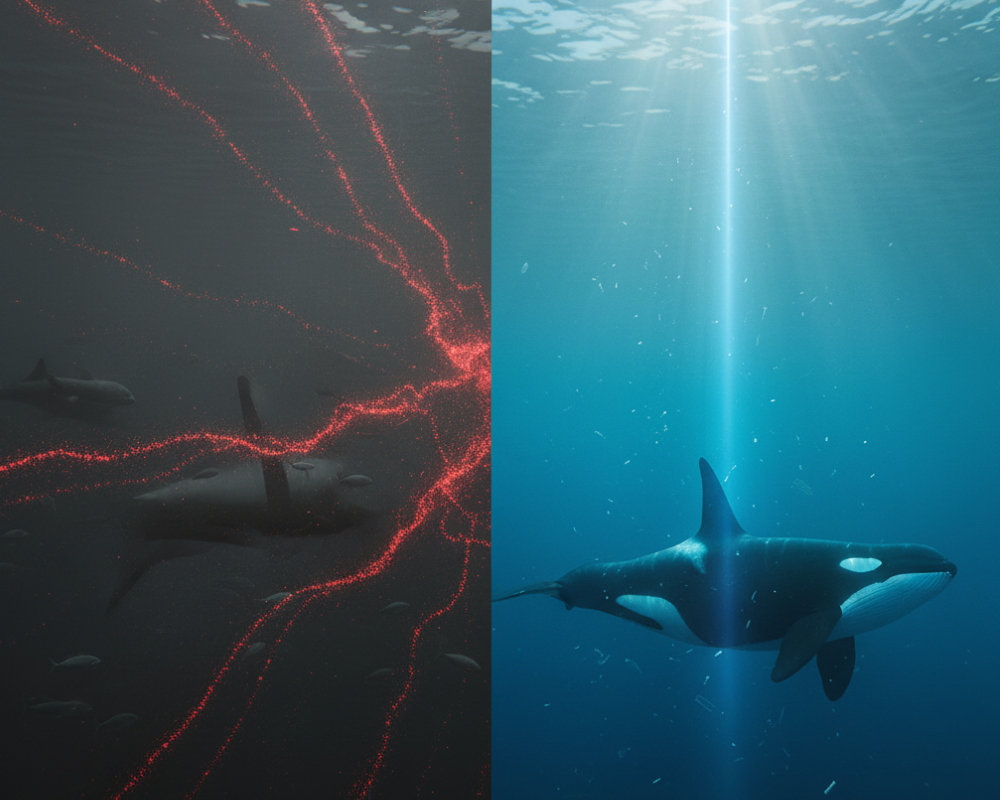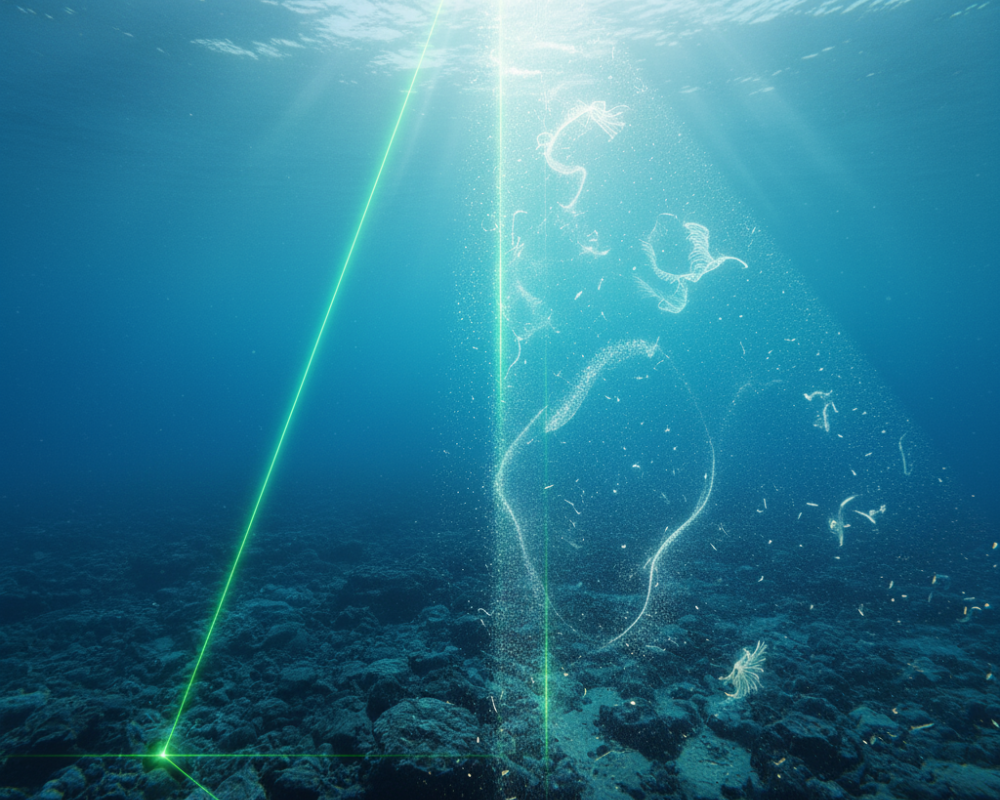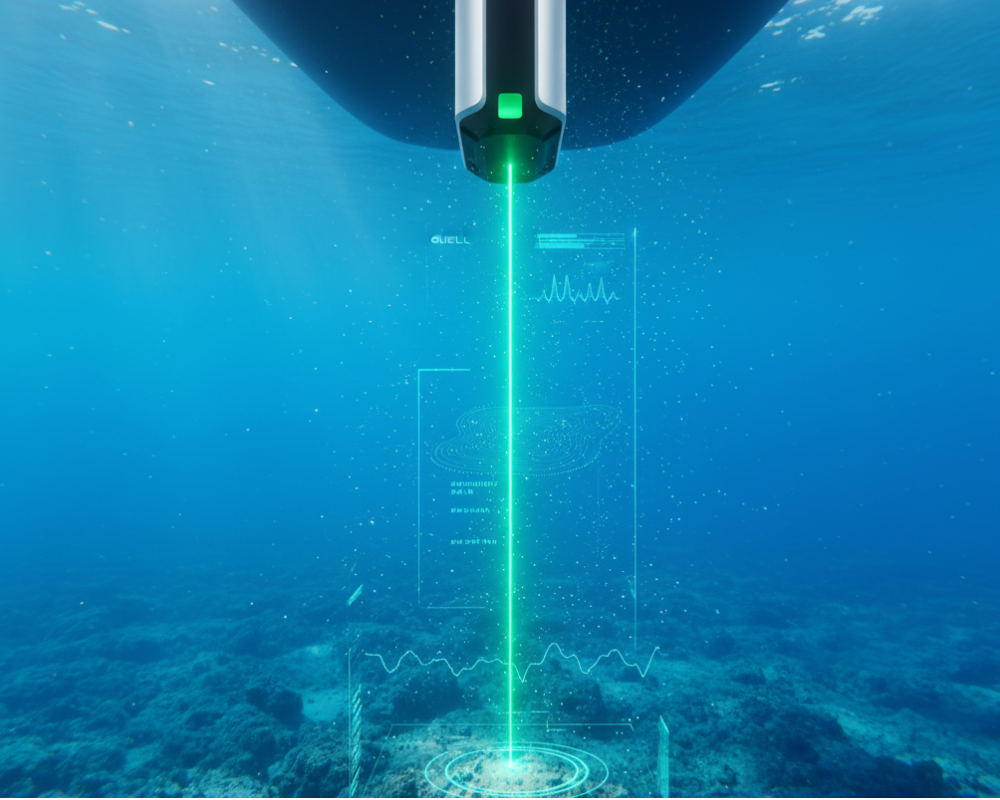From Seafloor to Water Column: The Dual-Use Evolution of Envisioning Labs' QUELL Technology
A New Way of Seeing Our Waters
Our oceans face a paradox. To keep vessels safe, we need to map the seafloor. But the tools we’ve relied on, acoustic sonar, fill the water with noise that confuses whales, dolphins, and other species that depend on sound to survive. Meanwhile, just above the seafloor, invisible dangers such as microplastics and chemical pollutants spread silently, threatening ecosystems and food chains.
What if a single technology could tackle both challenges?
That question inspired the creation of QUELL (Quiet Underwater Environmental Linear Lidar). Born from Transport Canada’s Quiet Vessel Initiative, Envisioning Labs designed a safer, quieter way to map the seafloor. What began as a navigation tool soon evolved into something greater: a dual-use system capable of not only charting the seabed but also revealing the hidden complexity of the water itself.
The ocean's paradox: chaotic noise from traditional sonar clashes with hidden microplastic threats, while QUELL offers a silent, clear solution.
The Journey: From a Clear Challenge to a Deeper Discovery
The original mission was straightforward: develop a silent, light-based alternative to sonar. Traditional acoustic systems are indispensable for bathymetry, or seafloor mapping, but they create underwater noise pollution that disrupts marine life. The endangered Southern Resident Killer Whales, for example, depend on echolocation to find food and communicate. A burst of sonar can cut through their conversations like static, blinding them in their own element.
Our goal was to deliver accuracy without harm.
In refining the technology, the team encountered a revelation. To detect faint pulses of light returning from the seafloor, QUELL had to be tuned with extraordinary sensitivity. That sensitivity unveiled more than just the ocean floor. What was once considered a challenge—the optical "noise" from turbidity—was reframed as a valuable new dataset. We began to reveal a hidden world within the water itself: suspended sediments, potential microplastics, and fragile ecosystems all came into focus.
This was not a diversion from the original mission. It was an expansion. QUELL transformed from a navigation tool into an instrument for both safe passage and environmental protection.
QUELL's evolution: from precise seafloor mapping to revealing the hidden complexities and pollutants within the water column.
The “How”: The Technology That Powered the Evolution
At its foundation, QUELL uses Time-of-Flight (ToF) lidar. Instead of sending out sound waves, it projects a narrow green beam of light at 520 nm and measures the time it takes to return—a method that is silent, precise, and safer for marine ecosystems.
The leap came through collaboration. By partnering with TRIUMF, Canada’s particle accelerator centre, we integrated Single Photon Avalanche Diode (SPAD) detectors into the system. These sensors are sensitive enough to capture the full waveform of returning light, providing a continuous trace instead of a single data point.
That breakthrough unlocked QUELL’s dual role. The system no longer just logs a reflection from the seafloor. It captures the entire light signal as it passes through the water and back. Our custom software translates this data into a high-resolution picture of both the bottom terrain and the water column above it. Mariners gain a safer navigation tool. Scientists gain a powerful instrument for environmental monitoring.
A close look at QUELL in action: silently mapping the seafloor and capturing real-time data from the water column.
The Dual Impact: Safer Navigation and Enhanced Conservation
Our progress has advanced QUELL from an early concept (TRL 3) to successful field demonstrations in real marine environments (TRL 6). This journey wasn't straightforward; it required our team to solve complex engineering hurdles, from developing algorithms to compensate for boat motion to pioneering new ways of interpreting light signals in turbid waters. By overcoming these challenges, we've proven that QUELL can reshape two critical domains.
Impact 1: A New Standard for Quiet Navigation
Operates in complete silence with no acoustic footprint.
Delivers bathymetric accuracy within ±10 cm.
Meets or exceeds the performance of many current sonar systems.
For coastal nations balancing shipping, tourism, and conservation, this represents a new baseline: vessels can navigate safely without adding to the underwater noise that stresses marine mammals.
Impact 2: A New Frontier in Environmental Monitoring
Detects and maps potential microplastic concentrations.
Identifies suspended sediments and pollutants that affect water quality.
Tracks habitats such as eelgrass meadows and kelp forests.
Supplies fresh datasets to strengthen climate resilience models.
With QUELL, environmental intelligence can be collected in the same pass that ensures navigational safety.
QUELL's dual impact: simultaneously ensuring safer navigation through precise bathymetry and enhancing conservation by monitoring environmental health.
The Canadian Story: Innovation Through Collaboration
QUELL is also a story about the strength of Canada’s innovation ecosystem. What began as a mandate to reduce vessel noise has grown into a partnership that includes Envisioning Labs, TRIUMF, and Laval University. Together, these organizations have built a knowledge cluster in underwater lidar, creating skilled jobs, developing intellectual property, and strengthening Canada’s role in the global Blue Economy.
A Clearer Future for Our Oceans
The evolution of QUELL shows how solving one challenge often reveals answers to others. While we have made a significant breakthrough, our work is not done. The next stage of our journey is focused on the crucial engineering challenges of transforming this powerful prototype into a field-ready, scalable solution. This includes developing an integrated system that eliminates reliance on laboratory equipment and creating the advanced machine learning algorithms needed to turn raw data into actionable intelligence, such as automated microplastic detection.
The long-term vision is bold yet achievable: fleets of autonomous vessels equipped with QUELL, mapping the seafloor while building a real-time, dynamic picture of the water column. The outcome would be safer shipping routes, cleaner coastlines, and healthier ecosystems.
Whether your focus is navigation, conservation, or the future of marine technology, QUELL represents a new path forward. We invite researchers, industry leaders, and potential partners to connect with our team and help us tackle the next set of challenges.




